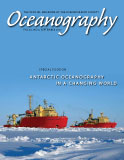Article Abstract
The Ross Sea, the most productive region in the Antarctic, reaches farther south than any body of water in the world. While its food web is relatively intact, its oceanography, biogeochemistry, and sea ice coverage have been changing dramatically, and likely will continue to do so in the future. Sea ice cover and persistence have been increasing, in contrast to the Amundsen-Bellingshausen sector, which has resulted in reduced open water duration for its biota. Models predict that as the ozone hole recovers, ice cover will begin to diminish. Currents on the continental shelf will likely change in the coming century, with a projected intensification of flow leading to altered deep ocean ventilation. Such changes in ice and circulation will lead to altered plankton distributions and composition, but it is difficult at present to predict the nature of these changes. Iron and irradiance play central roles in regulating phytoplankton production in the Ross Sea, but the impacts of oceanographic changes on the biogeochemistry of iron are unclear. Unlike other Southern Ocean regions, where continental shelves are very narrow and Antarctic krill dominates the herbivorous fauna, the broad shelf of the Ross Sea is dominated by crystal krill and silverfish, which are the major prey items for higher trophic levels. At present, the Ross Sea is considered to be one of the most species-rich areas of the Southern Ocean and a biodiversity “hotspot” due to its heterogeneous habitats. Despite being among the best-studied regions in the entire Southern Ocean, accurate predictions of the impacts of climate change on the oceanography and ecology of the Ross Sea remain fraught with uncertainty.

